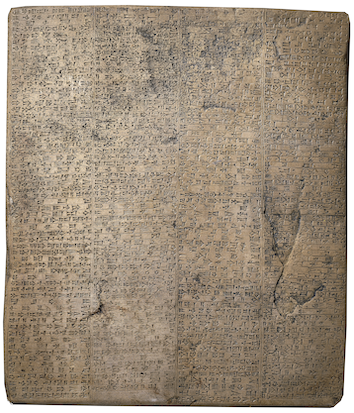Duku (Dais of Destinies, seat of Lugaldimmeranki in Esagil at Babylon)

Duku was the "Dais of Destinies" (Akkadian parak šīmāti) upon which the god Marduk (as Lugaldimmeranki) in Ubšukkina (the court of divine assembly), which convened on the eighth and eleventh days of the New Year's festival (Akkadian akītu). This holy seat of Babylon's tutelary god was most likely located inside Esagil (or its complex), since it was on Marduk's processonal route, between his cella in the temple's main building of Esagil and the Processional Way Ay-ibūr-šābû. The Neo-Assyrian king Ashurbanipal (r. 668–ca. 631 BC) and the Neo-Babylonian ruler Nebuchadnezzar II (r. 604–562 BC) worked on this seat of Marduk.
Names and Spellings
The Sumerian ceremonial name of Marduk's seat in Ubšukkina (whose full name is Ubšukkina-mezuhalhala) means "Pure Mound," which is a cosmic location situated somewhere in the eastern mountains, behind which the sun-god rises each and every day. The full name of Duku is Dukukinamtartarede, which translates as "Pure Mound, Where Destinies are Determined." Akkadian parak šīmāti ("Dais of Destinies") is a byname of Duku.

BM 129397, a large stone tablet that bears a long Akkadian inscription that is now commonly referred to as the "East India House Inscription." The description of Nebuchadnezzar's casting of Duku with gold is recorded in lines ii 54–iii 7. Image adapted from the British Museum Collection website. Credit: Trustees of the British Museum.
- Written Forms: du₆-ku₃, du₆-ku₃-ki-nam-tar-tar-e-de₃; du₆-ku₃-ki-nam-tar-tar-re-e-de₃.
Known Builders
- Neo-Assyrian (ca. 911–612 BC)
- Ashurbanipal (r. 668–ca. 631 BC)
- Neo-Babylonian (ca. 625–539 BC)
- Nebuchadnezzar II (r. 604–562 BC)
Building History
An Akkadian inscription of his written on a large stone tablet (the so-called "East India House Inscription") provides some details on the project. The relevant passage of that text reads:
It is unclear if Nebuchadnezzar had the entire structure of Duku recast with bricks made of gold — just like how Ashurbanipal, the last great king of Assyria, created Marduk's throne-dais in his cella Eumuša — or if he simply had it plated with metal. As to the identity of the "king of the past" mentioned in this inscription, the most likely candidate is probably Ashurbanipal because a badly damaged inscription of his preserves the very beginning of a description of his rebuilding of Duku. It is not impossible that Esarhaddon (r. 680–669 BC), Ashurbanipal's father, also worked on this "Dais of Destinies" since that Neo-Assyrian king sponsored a great deal of work on Esagil and it known to have built a Dais of Destinies" for the god Nabû (Marduk's son) at Borsippa.
Archaeological Remains
Duku has not yet been positively identified in the archaeological record. It was located somewhere between Marduk's seat (probably called Tiamat) in his cella Eumuša and Kasikila, the main gate of the Esagil complex, at the Processional Way Ay-ibūr-šābû. Although the "Dais of Destinies" was located in Ubšukkina (the court of divine assembly), it is not certain if that divine meeting place (which was used on the eighth and eleventh days of the New Year's festival) was in the Court of Bēl (the central courtyard of the main part of Esagil) or in courtyard of the eastern annex building. At present, the issue cannot be resolved with absolute certainty, given the lack for firm evidence.
Further Reading
- George, A.R. 1992. Babylonian Topographical Texts (Orientalia Lovaniensia Analecta 40), Leuven, pp. 287–291.
- George, A.R. 1993. House Most High. The Temples of Ancient Mesopotamia (Mesopotamian Civilizations 5), Winona Lake, p. 77 no. 180.
- Pongratz-Leisten, B. 1994. Ina Šulmi Īrub: Die kulttopographische und ideologische Programmatik der akitu-Prozession in Babylon und Assyrien im 1. Jahrtausend v. Chr. (Baghdader Forschungen 16), Mainz am Rhein, pp. 56–60.
Banner image: areal photograph of the excavation pits and trenches in the area of the remains of Esagil and Etemenanki taken in 1923 (left); a reconstruction of Esagil and Etemenanki during the reign of the Neo-Babylonian king Nebuchadnezzar II (center); a plan of Esagil, and Etemenanki (right). Images from O. Pedersén, Babylon: The Great City, pp. 144–145 figs. 4.3–4.4 and p. 151 fig. 4.11.
Jamie Novotny
Jamie Novotny, 'Duku (Dais of Destinies, seat of Lugaldimmeranki in Esagil at Babylon)', Babylonian Temples and Monumental Architecture online (BTMAo), The BTMAo Project, a sub-project of MOCCI, [http://oracc.org/btmao/Babylon/TemplesandZiggurat/Esagil/RoomsandGates/Duku/]